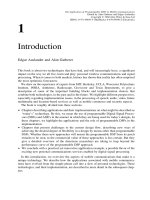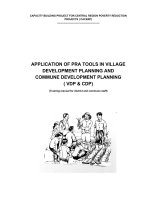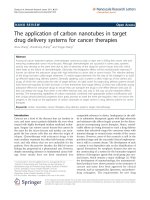Application of molecular markers in rice
Bạn đang xem bản rút gọn của tài liệu. Xem và tải ngay bản đầy đủ của tài liệu tại đây (4.75 MB, 115 trang )
Application of Molecular
Markers In Rice
Classification of main molecular markers
Types of molecular markers
Based on DNA
hybridization
Based on
PCR
amplification
Random
primer
Specific
primer
Single nucleotide
polymorphism
RFLP
RAPD 、 AFLP
AP 、 PCR 、 ISSR
SSR 、 STS 、 SCAR 、 CAPS
SSCP 、 TGGE 、 DGGE
SNP
Technologic Comparison of Main Molecular Markers
Markers
Based on
PCR or not
polymor
phism
hereditability
repeatability Automatizatio
n
cost
RFLP
No
Low/me
dium
Co-dominance
High
Low
High
RAPD
Yes
Medium/ dominance
high
Low
Medium
Low
SCAR/C
APS
Yes
High
Co-dominance
High
Medium
Medium
AFLP
Yes
High
dominance
High
Medium/high
Low
SSR
Yes
High
Co-dominance
High
Medium/high
Low
ISSR
Yes
High
dominance
High
Medium/high
Low
STS
Yes
High
Codominance
/dominance
High
Medium/high
Low
SRAP/ES
T
Yes
Medium
Co-dominance
High
Medium
Low
IRAP/RE
MAP
Yes
High
Co-dominance
High
Medium/high
Low
SNP
yes
Very
Co-
high
high
low
Demands of ideal molecular markers
Ideal molecular markers must meet the following demands:
(1) Have high polymorphism;
(2) Codominance heredity, meaning that they can distinguish
heterozygous and homozygous genotype in diploid;
(3) Can distinguish allele;
(4) Spread all over the genome;
(5) well-distributed in the genome except special sites;
(6) Have no pleiotropism;
(7) Have a simple and fast detection method ( e.g. experiment
procedures are easily automatized ( ;
(8) Have the development cost and use-cost as low as possible;
(9) Have excellent repeatability between laboratories ( available for
data exchange ( .
RFLP (Restriction Fragment Length Polymorphism)
RFLP has been widely used in genetic map construction of
genomes, gene mapping ( as well as biological evolution and
classification study. RFLP is based on different species (individuals)
whose genomes have endonuclease restriction sites of the base
mutation, or restriction sites between the bases of the insertion or
deletion which results in restriction fragment size changes. Such a
change can be carried out through specific detection probe
hybridization, which can discern differences of varieties (individual)
in the level of DNA (ie, polymorphism) and multiple probes can be
established by comparison of the evolution of biological relations
and classification. The used probes come from the same species or
different species of cloned genomic DNA and are located in different
chromosomal loci, which can be used as a molecular marker to build
molecular map.
When a trait (gene) coseparates with the molecular
markers, it indicates that the trait (gene) links to the
molecular markers. The exchange value between the
molecular markers and traits means the distance of the
target gene and molecular markers. Then genes can be
located in the molecular genetic map. After different
restriction endonucleases cut the genomic DNA, there will
be different types of cutting fragments. Therefore,
restriction enzymes and molecular markers can be
combined to study. Common restriction endonucleases are
Hind Ⅲ, BamH Ⅰ, EcoR Ⅰ, EcoRV and Xba Ⅰ. The more
molecular markers can build a more saturated map.
Construction of saturated RFLP map is one of the main
objectives of the study.
Characteristics of RFLP
1. RFLP markers are stable and reliable and the
detection
is
never
influence
by
environmental
conditions and the impact of developmental stages.
2. RFLP markers are codominant among alleles.
3. There is no epistatic effect between the non-alleles.
4. RFLP markers derive from genomic DNA of its own
variation and are virtually unlimited in the number.
The research of identification would not be desirable
for a large number of individuals(>200) because the
current RFLP technology is still expensive and laborious
with the complicated operation and requires a large
quantity of DNA samples.
RAPD ( Random amplified polymorphim )
•
RAPD technology is built on the basis of PCR
technology. It is using a series of (usually hundreds of )
different base sequences. These sequences use random
single-stranded oligonucleotide (usually 10 polymer) as
primers for the study of genomic DNA for PCR
amplification. Through polyacrylamide or agarose gel
electrophoresis separation and EB staining or
autoradiography to detect radioactive PCR products of
polymorphic DNA fragments, the PCR products reflect the
polymorphism of DNA fragments corresponding to
genomic region of DNA polymorphism.
Characteristics of RAPD :
RAPD technique is simple and easy to grasp compared
to
RFLP.
It
not
onlyovercomes
the
shortcomings
of
dificient isozyme loci but also avoids the disadvantages of
RFLP and the complicated operation. What’s more, it
doesn’t need the isotopic molecular hybridization, so the
general laboratory can use this technique.
Most RAPD molecular marker are dominant markers,
only a small number can be developed into codominant
markerd. Therefore, information provided is limited and
covers up the dominant homozygote and heterozygote
distinction. Meanwhile, markers themself are completely
dominant.
RAPD technique has a high false positive rate, if the
experimental condition is not very stringent, there
will be a higher false positive rate;
RAPD technique demands a high purity and is
sensitive to DNA reaction condition with a bad
repeatability;
For the markers attained by experiments, they must
be transformed into other kinds of markers to
suceed to map genes and enrich the genetic map.
AFLP (Amplified restriction fragment polymorphism)
•
Netherlandish scientists Zabeau and Vos
developed the detection technology on DNA
polymorphism of molecular markers in 1993. AFLP
technology is based on the PCR reaction of a
selective restriction fragment amplification method.
Due to the different size of genomes of different
species, the genome DNA will lead to different sizes
of restriction fragment after restriction
endonuclease digestion.
Characteristics of AFLP
It has a very high level of
polymorphism which is stable and
reliable. But it goes with a large
quantity of DNA template and
complex steps. At the same time
the cost is too high and it is a
patented technology.
ISSR (inter simple sequence repeat)
•
ISSR molecular marker is a new technology on the
basis of SSR markers . Its basic principle is that in
the SSR of the 5 'or 3' end 1 to 4 base are anchored
in the form of purine or pyrimidine. Then amplify
DNA sequences. Repeat sequence and anchoring
base is randomly selected. PCR products separated
by polyacrylamide or agarose gel electrophoresis,
can produce more amplified fragment than RAPD.
Therefore, ISSR technique is a fast, reliable and
information-rich genomic DNA fingerprinting.
Characteristics of ISSR
(( Simple, low cost, strong ability to detect
polymorphism, required less DNA template. Has
been successfully applied to study population
biology, species identification, species comparison
of the classification system and as a tool to build a
genetic map. However, ISSR markers are generally
dominant, with each primer amplifying 6 bands,
which can not be used for identification of seed
purity of hybrid rice.
Micro-satellite or SSR (simple sequence repeat)
•
Micro-satellite DNA ( referring to a
section of DNA consisting of 1 to 6
nucleotides repeats of basic units, is
widely distributed in the genome of
different locations, and the length is
generally 200bp below.
Characteristics of SSR
SSR has the rich number , covers the whole
genome, reveals high polymorphism :
Has characteristics of multiple alleles, provide
high amount of information :
Abide to Mendelian genetics, is codominant :
Each site is determined by primer sequences
to facilitate mutual exchanges and cooperation
in different laboratories and to develop
primers to obtain the information which can be
repeated in different laboratories and shared.
Advantages of SSR
1) SSR
does
not
require
the
use
of
isotopes, reducing harm to staff :
2)
SSR experiment has little amount of DNA, reducing
the
work of
experiment
a
does
large
not
number of
require
extraction;
Southern
the
transfer,
hybridization etc.
3)
SSR materials , used in the experiment without
having sexual generation, can be used for any single
parent or any part of the material,for example DNA in
the mitochondria and chloroplast studies may be
used.
STS (sequence-tagged site)
•
Sequence-tagged site is a class of tags
defined by specific sequence primers.
The biggest advantage of technologyspecific PCR is that it has a very reliable
information, rather than RAPD, AFLP and
random RFLP probe generating the
existence of ambiguity.
EST (expressed sequence tags)
•
EST (expressed sequence tags) provides a
valuable resource for the development of
molecular markers. Compared to the
traditional markers from genomic DNA, ESTbased molecular markers are a new molecular
marker and have its obvious advantages,
such as the simplicity and high information
,resulting in a lot of important value.
SCAR (Sequence-characterized Amplified Region)
•
Sequence-characterized Amplified Region marker is usually
transformed from RAPD. In order to improve the applied
stability of found RAPD markers, we can design a pair of
primers (18-24 base around) according to its base sequence.
We can also sequence the end fragments of the RAPD
markers and add 14 bases to its end of sequence into the
original 10 bases, becoming the complementary primer of
the original RAPD fragment. Then carry out PCR amplification
using the primers specific to genomic DNA and we can get
the same specific size of cloned fragments. This molecular
marker-specific DNA markers after transformation is called
SCAR.
•
SCAR marker is a kind of dominant marker in the
form of existence of amplified fragments, but
sometimes in the form of the length. Compared
with the RAPD markers, SCAR markers can be
amplified under stringent conditions, resulting in
good stability, repeatability. With the
development of research work, there will be more
and more SCAR markers to be developed, which
will play a huge role in the molecular markerassisted breeding .
Application of Molecular Markers
in Molecular Biology
1 For species-specific identification and
protection of new varieties
2 Determine the evolutionary relationship
3 Track the exogenous gene
4 Identify the specific chromosome DNA
fragment to find the target genes linked
to molecular markers for gene mapping
and gene isolation
5 Genetic mapping
6 Hybrid rice seed purity detection
Here is the brief introduction
about gene location, molecular
breeding and hybrid rice seed purity
detection using SSR in our lab:
1.Gene Location Using SSR
Locate semi-dwarf gene in rice
、
Use Xiaoxiang’ai and Xiangzao143(earlly indica) for
parents and their 116 plants of F2 to construct a tall gene
pool and a dwarf gene pool.Then utilize 359
microsatellite primers distributed in chromosomes 1-12 to
analyze polymorphism of the two gene pools.
•
The rapid extraction method is used
for each rice leaf to extract DNA. Then
analyze PCR amplification and we find
that RM249 on chromosome 5 has
polymorphism for 116 dwarf individuals
to verify the chain relationship between
the dwarf gene. We conclude that the
genetic distance between marker RM249
and target gene is about 1cM. So it is a
new dwarf gene.









